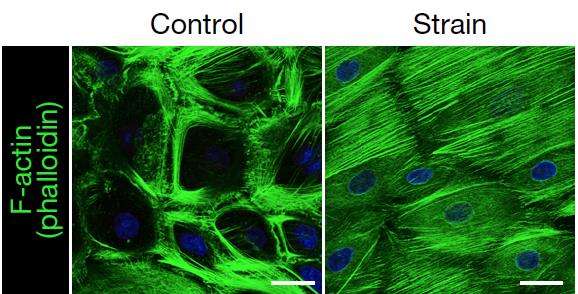Stem cells respond to mechanical forces by changing their structure

A team of scientists led by Sara Wickström, Principal Investigator at CECAD, the Cluster of Excellence in Cellular Stress Responses in Aging-associated Diseases at the University of Cologne, gained new insights into how stem cells feel and respond to external mechanical forces by changing the way DNA is organized in the nucleus, and thereby the expression of genes that are required for stem cell differentiation.
All cells share the same genetic code, no matter if they are skin or brain cells. However, these cells are exposed to very different types of mechanical environments and mechanical stresses. For example, brain tissue is very soft, whereas bone is hard. Researchers know that cells respond to extrinsic forces by changing their structure and their gene expression to be better suited for their particular environments and to be able to execute their specific functions. The molecular mechanisms of this regulation are, however, not yet clear
"Our skin protects us against the outside world while being constantly exposed to toxic insults, injuries, UV radiation and mechanical strain. Therefore it is particularly important for skin cells to be able to respond to forces", says Huy Quang Le, the leading scientist of the study that was conducted at the Max-Planck-Institute for Biology of Ageing, a cooperation partner of CECAD. The results are published in Nature Cell Biology.
To study how skin cells respond to forces, Le and his colleagues used a special mechanical device to expose skin stem cell cultures to similar mechanical stretch that they would experience inside the tissues. The analysis of the gene expression of these mechanically stretched stem cells using next generation sequencing revealed that thousands of genes were downregulated, whereas very few genes increased their expression. Further research revealed that stretch induced global changes in how DNA is packed within the nucleus. This resulted in a widespread repression of the transcriptional activity of the cell, which means that less DNA is copied into messenger RNA to generate proteins. For a stem cell to differentiate, it needs to transcribe a large number of genes to acquire its specialized architecture and function. As a result of the mechanical strain, stretched stem cells would not differentiate in the presence of a differentiation signal. "It was exciting to realize that we could alter the structural organization of DNA simply by exerting mechanical forces on the stem cells", says Sara Wickström.
Going deeper into the cellular mechanism of the DNA rearrangements, Le and his colleagues found out that the mechanical forces were being sensed at the nuclear envelope, a structure that surrounds the DNA and separates it from the rest of the cell. A key molecule in this force sensing was a protein called emerin, which links the nucleus and DNA to the cytoskeleton, the force bearing structure of the cell. This was particularly interesting, as emerin is mutated in a disease called Emery-Dreifus muscular dystrophy, which causes patients to suffer from a degeneration of mechanically strained tissues such as the skeletal muscle, heart, and also skin. "As the precise pathomechanisms of this disease are unknown and we lack efficient treatment, a major future goal of the laboratory is to understand whether the mechanisms uncovered in this study play a role in the pathogenesis of the disease", says Sara Wickström. As the mechanical properties of tissues change with age, another objective is to understand how aged stem cells sense forces and how the altered mechanical properties of the surrounding tissue would alter this.
More information: Mechanical regulation of transcription controls Polycomb-mediated gene silencing during lineage commitment; Huy Quang Le, Sushmita Ghatak, Ching-Yan Chloé Yeung, Frederik Tellkamp, Christian Günschmann, Christoph Dieterich, Assa Yeroslaviz, Bianca Habermann, Ana Pombo, Carien M. Niessen, Sara A. Wickström; Nature Cell Biology; DOI: 10.1038/ncb3387
Journal information: Nature Cell Biology
Provided by University of Cologne



















